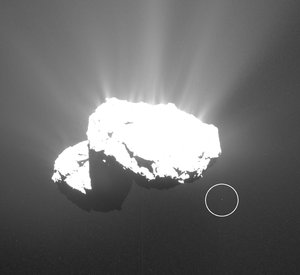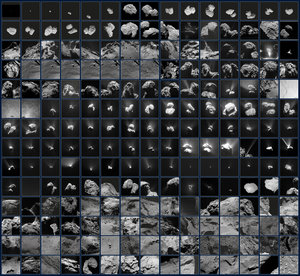Accept all cookies Accept only essential cookies See our Cookie Notice

About ESA
The European Space Agency (ESA) is Europe’s gateway to space. Its mission is to shape the development of Europe’s space capability and ensure that investment in space continues to deliver benefits to the citizens of Europe and the world.
Highlights
ESA - United space in Europe
This is ESA ESA facts Member States & Cooperating States Funding Director General Top management For Member State Delegations European vision European Space Policy ESA & EU Space Councils Responsibility & Sustainability Annual Report Calendar of meetings Corporate newsEstablishments & sites
ESA Headquarters ESA ESTEC ESA ESOC ESA ESRIN ESA EAC ESA ESAC Europe's Spaceport ESA ESEC ESA ECSAT Brussels Office Washington OfficeWorking with ESA
Business with ESA ESA Commercialisation Gateway Law at ESA Careers Cyber resilience at ESA IT at ESA Newsroom Partnerships Merchandising Licence Education Open Space Innovation Platform Integrity and Reporting Administrative Tribunal Health and SafetyMore about ESA
History ESA Historical Archives Exhibitions Publications Art & Culture ESA Merchandise Kids Diversity ESA Brand Centre ESA ChampionsLatest
Space in Member States
Find out more about space activities in our 23 Member States, and understand how ESA works together with their national agencies, institutions and organisations.
Science & Exploration
Exploring our Solar System and unlocking the secrets of the Universe
Go to topicAstronauts
Missions
Juice Euclid Webb Solar Orbiter BepiColombo Gaia ExoMars Cheops Exoplanet missions More missionsActivities
International Space Station Orion service module Gateway Concordia Caves & Pangaea BenefitsLatest
Space Safety
Protecting life and infrastructure on Earth and in orbit
Go to topicAsteroids
Asteroids and Planetary Defence Asteroid danger explained Flyeye telescope: asteroid detection Hera mission: asteroid deflection Near-Earth Object Coordination CentreSpace junk
About space debris Space debris by the numbers Space Environment Report In space refuelling, refurbishing and removingSafety from space
Clean Space ecodesign Zero Debris Technologies Space for Earth Supporting Sustainable DevelopmentLatest
Applications
Using space to benefit citizens and meet future challenges on Earth
Go to topicObserving the Earth
Observing the Earth Future EO Copernicus Meteorology Space for our climate Satellite missionsCommercialisation
ESA Commercialisation Gateway Open Space Innovation Platform Business Incubation ESA Space SolutionsLatest
Enabling & Support
Making space accessible and developing the technologies for the future
Go to topicBuilding missions
Space Engineering and Technology Test centre Laboratories Concurrent Design Facility Preparing for the future Shaping the Future Discovery and Preparation Advanced Concepts TeamSpace transportation
Space Transportation Ariane Vega Space Rider Future space transportation Boost! Europe's Spaceport Launches from Europe's Spaceport from 2012Latest

Comet storm
Thank you for liking
You have already liked this page, you can only like it once!
Perhaps you live in a part of the world where you regularly experience snow storms or even dust storms. But for many of us, the weather forms a natural part of everyday conversation – more so when it is somewhat extreme, like a sudden blizzard that renders transport useless or makes you feel highly disoriented as you struggle to fix your sights on recognisable landmarks.
ESA’s Rosetta mission had a similar experience, for more than two years, as it flew alongside Comet 67P/Churyumov–Gerasimenko between 2014 and 2016. It endured the endless impacts of dust grains launched by gaseous outpourings as the comet’s surface ices were warmed by the heat of the Sun, evaporating into space and dragging the dust along.
This image was taken two years ago, on 21 January 2016, when Rosetta was flying 79 km from the comet. At this time Rosetta was moving closer following perihelion in the previous August, when the comet was nearer to the Sun and as such at its most active, meaning that Rosetta had to operate from a greater distance for safety.
As can be seen from the image, the comet environment was still extremely chaotic with dust even five months later. The streaks reveal the dust grains as they passed in front of Rosetta’s camera, captured in the 146 second exposure.
Excessive dust in Rosetta’s field of view presented a continual risk for navigation: the craft’s startrackers used a star pattern recognition function to know its orientation with respect to the Sun and Earth. On some occasions flying much closer to the comet, and therefore through denser regions of outflowing gas and dust, the startrackers locked on to dust grains instead of stars, creating pointing errors and in some cases putting the spacecraft in a temporary safe mode.
Despite its dangers, the dust was of high scientific interest: three of Rosetta’s instruments studied tens of thousands of grains between them, collectively analysing their composition, their mass, momentum and velocity, and profiling their 3D structure. Studying the smallest and the most pristine grains ejected is helping scientists to understand the building blocks of comets.
Two years before the image was taken, 20 January 2014, Rosetta was only just waking up from 31 months of deep-space hibernation. It arrived at its destination after 10 years in space in August 2014, and released the lander Philae three months later. Rosetta made unique scientific observations of the comet until reaching its grand finale on 30 September 2016 by descending to the comet’s surface. By the end of the mission, more than a hundred thousand images had been taken by the high-resolution OSIRIS camera (including the one shown here) and the navigation camera, the majority of which are available to browse in the Archive Image Browser.
-
CREDIT
ESA/Rosetta/MPS for OSIRIS Team MPS/UPD/LAM/IAA/SSO/INTA/UPM/DASP/IDA -
LICENCE
ESA Standard Licence

An unexpected companion

Dust on 4 March 2016 – OSIRIS narrow-angle camera

Rosetta’s ever-changing view of a comet

Summer fireworks on Rosetta’s comet















 Germany
Germany
 Austria
Austria
 Belgium
Belgium
 Denmark
Denmark
 Spain
Spain
 Estonia
Estonia
 Finland
Finland
 France
France
 Greece
Greece
 Hungary
Hungary
 Ireland
Ireland
 Italy
Italy
 Luxembourg
Luxembourg
 Norway
Norway
 The Netherlands
The Netherlands
 Poland
Poland
 Portugal
Portugal
 Czechia
Czechia
 Romania
Romania
 United Kingdom
United Kingdom
 Slovenia
Slovenia
 Sweden
Sweden
 Switzerland
Switzerland
























